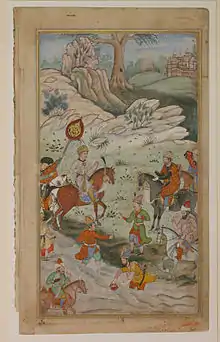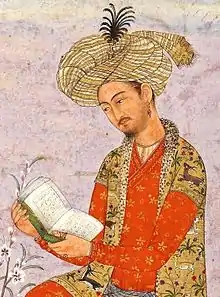Mirza
Mirza (/ˈmɜːrzə/ or /mɪərˈzɑː/; Persian: میرزا)[1][lower-alpha 1] is a name of Persian origin. It is used as a surname or prefix to identify patriarchal lineage.
It is derived from a historical royal and noble title,[2] denoting the rank of a royal prince,[3] high nobleman,[4] distinguished military commander,[5] or a scholar.[6]
Specifically, it was used as a title by and today signifies patriarchal lineage to the various Persian Empires, the Nogai Horde, Shirvanshahs and Circassians of the European Caucasus, as well as the Muslim Rajputs[7] and mainly the Mughals / Moguls, both of the Indian Subcontinent. It was also a title bestowed upon members of the highest aristocracies in Tatar states, such as the Khanates of Kazan and Astrakhan.
Etymology
The original title Mīrzā or Merzāh is derived from the Persian term Amīrzādeh which literally means child of the Amīr or child of the ruler.[8] Amīrzādeh in turn consists of the Arabic title Amīr (English: Emir), meaning "commander" and the Persian suffix zādeh, meaning "son of" or "lineage of".[9] Due to vowel harmony in Turkic languages, the alternative pronunciation Morza (plural morzalar; derived from Persian) is also used.
History
Mirza first emerged during the 15th century as an appellative term for members of the Timurid dynasty, adopted in deference to their progenitor, the Central Asian conqueror Timur, who used Amir as his principal title.[10][11] During the early Timurid period, Mirza preceded a prince's given name, therefore adhering to the Persian fashion, though subsequently the Turkish style was adopted, with the title instead being placed after.[12] This was continued by later rulers such as the Aq Qoyunlus, Safavids and Mughals.[10]
Originally restricted to only kings and princes,[13] the title eventually spread among other social groups, though only the former could have it placed after their given name.[14] During the 16th century, the Safavids conferred it upon high-ranking viziers such as Mirza Shah Hossein and Mirza Ata-Allah Isfahani.[10] By the Qajar period, the title simply marked a person as a clerk or a literate man of consequence.[15] Writing in 1828, Frederic Shoberl records that "as a prefix to the name, it may be assumed by, or conferred on any person. It is right, however, to observe, that none but well-educated men, or such as follow respectable professions, or hold honourable posts, take the title of mirza."[14]
Persian Empires
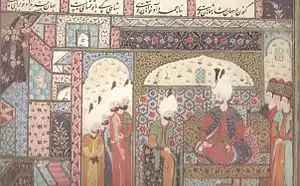
Safavid dynasty
- Padeshah Ali Mirza
- Prince Alqas Mirza
- Prince Mohammad Baqer Mirza
- Vizier Mirza Shokrollah Isfahani
- Vizier Mirza Salman Jaberi
- Vizier Mirza Shah Hossein
Afsharid dynasty
- Prince Reza Qoli Mirza
- Prince Shahrokh Mirza
- Prince Ebrahim Mirza
- Statesman Mirza Mehdi Khan
- Prince Nader Mirza
Qajar dynasty
- Prince Iraj Mirza
- Prince Malek Mansur Mirza Shao es-Saltaneh
- Prince Bahram Mirza Sardar Mass'oud
- Prince Abbas Mirza
- Prince Abdol Majid Mirza
- Prince Ali-Mohammad Mirza
- Prince Bahram Mirza
- Prince Djahangir Mirza
- Prince Eskandar Mirza
- Prince Hamid Mirza
- Prince Khanlar Mirza
- Prince Khosrow Mirza
- Prince Muhammad Mirza
- Prince Mahmoud Mirza
- Prince Mohammad Hassan Mirza
- Prince Mohammad Hassan Mirza II
- Prince Ahmad Shah Qajar
- Prince Nosrat-od-Dowleh Firouz Mirza
- Prince Firouz Mirza Nosrat-ed-Dowleh Farman Farmaian III
- Prince Ali Mirza Qajar
- Prince Nosrat al-Din Mirza Salar es-Saltaneh
- Prince Abdol-samad Mirza Ezz ed-Dowleh Saloor
- Prince Mass'oud Mirza Zell-e Soltan
- Prince Mohammad Ali Mirza Dowlatshah
- Prince Mohammad Taqi Mirza
- Prince Kamran Mirza Nayeb es-Saltaneh
Shirvanshahs
Three consecutive titular kings of Shirvan, of the Shirvanshah Dynasty (present-day Azerbaijan), adopted the title as well following the death of Gurban Ali.
Circassians
Circassian dynasty
The hereditary title of Mirza was adopted by the nobility class of the Circassians. Idar of Kabardia, also known as "Mirza Haydar Temruk Bey", was the great-grandson of Prince Inal – Sultan of Egypt the founder of the "Temruk dynasty" of the Kabardian princes, known in Russia as the "Cherkassky" a Circassian princely family.
Circassian nobility with the name Mirza include:
- Mirza Haydar Temruk Bey (ca. 1470 – 1571)
Princely Issues:
- Temruk Mirza (ca. 1501 – 1571)
- Kambulat Mirza (ca. 1510 – 1589)
- Zhelegot Mirza (ca. 1520- ?)
Russian Empire
Under Catherine the Great, empress of Russia, the Mirzas gained equal rights with the Russian nobility due to their extreme wealth. Abdul Mirza was given the title Prince Yusupov, and his descendant Prince Felix Yusupov married Princess Irina Alexandrovna of Russia, the only niece of Tsar Nicholas II.
Mughal Empire
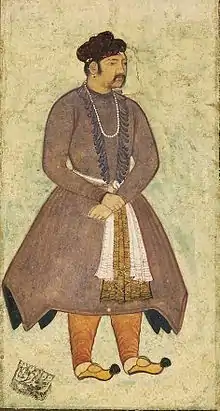
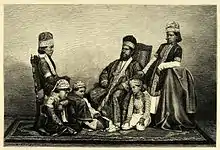
In the Indian subcontinent, the title Mirza was borne by an imperial prince. It was adopted as part of ones name, implying relationship to the Turk dynasties like the Mughal Dynasty (the Imperial House of Timur).[18] In the traditional naming sequence of the Indian royal families, the title can be placed both before the name and after it, such as Prince Mirza Mughal or Prince Kamran Mirza. Prince Khusrau Mirza was the grandson of Emperor Babur (Babur Mirza), son of Emperor Jahangir and a brother of Emperor Shah Jahan. Emperor Akbar Shah II was known as Prince Mirza Akbar before his coronation. Emperor Babur took the imperial title of Padishah on 6 March 1508, before which he used the title Mirza.[19]
Mughal dynasty
- Mirza Zahirudin 1523–1530, first Mughal Emperor.
- Mirza Nasiruddin 1530–1539 & 1554–1555, second Mughal Emperor.
- Mirza Jalaluddin 1555–1605, third Mughal Emperor.
- Mirza Nuruddin 1605–1627, fourth Mughal Emperor.
- Mirza Khurram 1627–1658, fifth Mughal Emperor.
- Mirza Muhiuddin 1658–1707, sixth Mughal Emperor.
- Mirza Azam 1707, seventh Mughal Emperor.
- Mirza Mu'Azzam 1707–1712, eighth Mughal Emperor.
- Sultan Muizuddin Mirza 1712–1713, ninth Mughal Emperor.
- Mouinudd'in Muhammad Mirza 1712–1719, tenth Mughal Emperor.
- Sultan Shamsuddin Mirza 1719, eleventh Mughal Emperor.
- Sultan Rafiuddin Mirza (later Shah Jahan II) 1719, twelfth Mughal Emperor.
- Sultan Nekusiyar Mirza 1719, thirteenth Mughal Emperor.
- Sultan Akhtar Mirza, fourteenth Mughal Emperor.
- Ahmad Shah Mirza 1720–1748, fifteenth Mughal Emperor.
- Aziz 'ud-Din Beg Mirza 1754–1759, sixteenth Mughal Emperor.
- Jalal 'ud-Din Mirza 1759–1760, seventeenth Mughal Emperor.
- Muhi-ul-millat Mirza 1788–1806, eighteenth Mughal Emperor.
- Mirza Akbar 1806–1837, nineteenth Mughal Emperor.
- Sirajuddin Mirza 1837–1857, Mughal Emperor.
- Mirza Abdullah, son of Bahadur Shah II 1850–1897, Mughal Emperor.
- Mirza Aziz Koka (1542–1624), foster-brother of Akbar, son of Ataga Khan
Royal family of Bengal
Imperial families of Central India and Bengal The archaic Bengali form of Mirza was Mridha in Bengal and Bihar.[20]
- Mirza Shuja ud-din Muhammad Khan, second Nawab of Bengal, Bihar and Orissa.
- Mirza Asadullah, third Nawab of Bengal, Bihar and Orissa.
- Mirza Muhammad Ali, fourth Nawab of Bengal, Bihar and Orissa.
- Mirza Mohammad Siraj, fifth Nawab of Bengal, Bihar and Orissa.
- Mirza Hassan Ali Khan Bahadur, 18th Nawab of Bengal, Bihar and Orissa.
- Mirza Wasif Ali Khan, 19th Nawab of Bengal, Bihar and Orissa.
- Mirza Waris Ali Khan, 20th Nawab of Bengal, Bihar and Orissa.
Royal family of Awadh
- Mirza Muhammad Muqim Ali Khan, second Nawab Subahdar of Awadh (Oudh)
- Mirza Amani Asif-ud-Dawlah, fourth Nawab Subahdar of Awadh
- Mirza Asif Jah Wazir Ali Khan, fifth Nawab Subahdar of Awadh
- Mirza Wajid Ali Shah, eleventh Nawab Subahdar (fifth King) of Awadh
Rajput dynasty
Rajputs of Northern India
Originally being adversaries and opponents to the Mughal Emperors of Northern India, the title Mirza was also adopted by the Muslim Rajputs of Northern India.[21] The Rajput imperial families were descendants of ancient Indo-Aryan warriors who strategically formed blood alliances with Mughal aristocracy. The Rajputs were rulers of princely states comprising vast territories of Northern India, including the Punjab Region, Kashmir and Rajasthan. Inter-marriage between Mughal aristocracy and Rajput aristocracy became very common and various factions of Rajput kingdoms embraced the Islamic faith, giving rise to the term "Muslim Rajputs".[22] Rajput rulers were also granted the title Mirza on account of being high-ranked commanders in the Mughal military.[23] The meaning of Mirza (Persian origin)[24] is identical to the meaning of Rajput (Sanskrit Origin).[25]
Other notable Mirzas
Sport
- Sania Mirza, Indian tennis player, former WTA number 1
- Fadi Merza, Syrian-Austrian middleweight kickboxer, former world champion kickboxing and Muay Thai
- Mirza Ali Baig, Pakistani mountaineer
- Mirza Bašić, Bosnian tennis player, winner 2018 Sofia Open
- Mirza Begić, Slovenian Olympic basketball player
- Mirza Delibašić, Bosnian basketball player
- Mirza Teletović, Bosnian basketball player
- Rasul Mirzaev, Russian MMA fighter
Academics and literature
- Heidi Safia Mirza (born 1958), British academic
- Iraj Mirza, Persian folk poet, also known as Jalaal-al-mamalek.
- Mirza Abu Taleb Khan, tax-collector and administrator from northern India, writer of an early travel guide to Europe.
- Mirza Athar Baig is a Pakistani novelist, playwright and short story writer.
- Mirza Gʻafur Gʻulom, Uzbek poet, writer, and literary translator, considered one of the most influential Uzbek writers of the 20th century.
- Mirza Ghalib (born Mirza Asadullah Baig Khan), an Urdu and Persian poet from South Asia who adorned the Mughal court.
- Mirza Kalich Beg, Sindhi writer.
- Mirza Khan of "Mirza & Sahiba", a tragic romance story, based on true events, which is enshrined in Punjabi literature and commonly told in the Punjab region. Mirza of "Mirza & Sahiba" was of Kharal Muslim Rajput / Muslim Jat tribe of Puar Rajput descent.
- Muhammad Munawwar Mirza, a prominent scholar, historian, writer and intellectual from Pakistan.
- Nawab Mirza Khan "Daagh", Urdu poet.
- Mirza Beigh Family from Jammu & Kashmir's Srinagar district have immensely worked and contributed for Shia Literature under the genre of elegy commonly called "Kashmiri noha". Some of noted family members include Mirza Abdul Ghani Beigh, Mirza Manzoor Hussain Beigh and Mirza Sharafat Hussain Beigh.[26]
Entertainment
- Aziz Mirza (born 1947), Indian film director, producer and writer.
- Dia Mirza, Indian actress and former "Miss Asia Pacific" titleholder.
- Mastan Haider Mirza, Indian Mafia boss, mobster and filmmaker; popularly known as the first "celebrity gangster" of Bombay.
- Mirza Babayev, Azerbaijani movie actor and singer. Honored Artist of the Azerbaijan SSR and People's Artist of Azerbaijan.
- Mirza Nadeem Baig Mirza Nazeer Baig Mughal better known by his stage name Nadeem Baig, a Pakistani actor, singer and producer.
- Mohib Mirza is a Pakistani actor and television host.
- Saeed Mirza, Indian film director and screenwriter, considered one of the most influential parallel cinema movie makers in India.
Arts
- Bashir Mirza also known as BM, a Pakistani painter.
- Haroon Mirza, Anglo-Pakistani artist born in London.
- Mirza Kadym Irevani, Azerbaijani artist.
- Shazia Mirza, English comedian.
Government
- Mirza Fakhrul Islam Alamgir, Bangladeshi politician, the incumbent secretary general of the Bangladesh Nationalist Party (BNP) since 2016
- Mirza Abbas, Bangladesh Nationalist Party politician. He was the Mayor of Dhaka City Corporation from 1991 to 1993
- Fahmida Mirza, first female Speaker of the National Assembly of Pakistan
- Hasnain Mirza, lawyer, barrister and Member of Parliament who was Member of Provincial Assembly(MPA)
- Iskandar Ali Mirza, the first President and 4th Governor General of the Islamic Republic of Pakistan in 1956
- Mirza Ali Asghar Khan Amin al-Soltan, the last prime minister of Iranunder Naser al-Din Shah Qajar
- Mirza Ismail, Prime Minister, Jaipur (Diwan of Jaipur) (1942–1946)
- Mirza Kuchik Khan, early 20th-century revolutionary, Gilani Nationalist and the president of the Republic Of Gilan
- Mirza Muzaffar Ahmad, a Federal Finance Minister and Finance Secretary, Chairman of Planning Commission of Pakistan Executive director of the World bank
- Mirza Nasrullah Khan, the first Iranian Prime Minister
- Munira Mirza, Deputy Mayor of London
- Zulfiqar Mirza, Pakistani politician affiliated with the Pakistan Peoples Party (PPP)
Judges and advocates
- Jerome Mirza (1937-2007), was a prominent American lawyer, barrister, published author and philanthropist. A native of Chicago, he was a prominent member of the Illinois legal community from the early 1960s until his passing. He ran a multi-million dollar legal practice, was the former president of the Illinois State Bar Association and Illinois Trial Lawyers Association, founded the Jerome Mirza College of Advocacy at Illinois Wesleyan University and the University of Illinois and published numerous legal textbooks, including "Winning Litigation the Mirza Way". He is survived by the Jerome Mirza Foundation and Mirza and Associates, which continues to operate as a prominent boutique law firm in Illinois.
- Mirza Aziz Akbar Baig, Former Vice Chairman of Pakistan Bar Council.
- Zafar Hussain Mirza, Pakistani judge and the father of former Home Minister of Sindh Zulfiqar Mirza.
Journalist
- Janbaz Mirza was a writer, poet, and journalist from Pakistan.
- Tahir Mirza was a senior Pakistani journalist and former editor of Dawn, Pakistan's oldest and most widely circulated English-language newspaper.
Military
- Mirza Ahmed Bey, one of the original Punjabi soldiers of the famed "Hodson's Horse" regiment of the British Indian Army, pictured in the historical 1858 photograph. He was a descendant of Mirza Hakim Bey, after whom the Indian village Hakimpur, Gurdaspur District is named.
- Mirza Aslam Baig a Former Chief of Army Staff of Pakistan.
- Mirza Ghulam Murtaza was the chieftain of Qadian and a commander with the Sikh Army.
- Mirza Kuchak Khan was a Persian revolutionary who led the Jungle Movement in the northern jungles of Gilan Province.
Nobility
- Khan Muhammad Mirza, Architect during the Mughal Era.
- Mirza Ali Behrouze Ispahani, Bangladeshi businessman from the Ispahani family and the chairman of M. M. Ispahani Limited.
- Mirza Hadi Baig, Mughal nobleman from Samarkand who was granted 80 villages by Babur.
- Mirza Najaf Khan, Indian Courtier and Commander in Chief of the Mughal Imperial Army.
- Sikandar Mirza, Armenian courtier within Akbar's Mughal Empire
Movies
- Mirza – The Untold Story – Punjabi language Movie from India
- Mirzya (film) – Hindi language Movie from India
- Mirza Juuliet – Hindi language Movie from India
See also
Further reading
- Life of a Mirza Chapter 7 (pg 225–227) The Empire of the Great Mughals: History, Art and Culture (2004) by Annemarie Schimmel ISBN 1-86189-185-7
- Mirzah in The Wordsworth Dictionary of Phrase and Fable By Ebenezer Cobham Brewer: The quintessential guide to myth, folklore, legend, legend and literature. ISBN 1-84022-310-3
- MI’RZA Chambers's Encyclopaedia: A Dictionary of Universal Knowledge For the People. ISBN 1-149-98693-X
- A. Jaimoukha The Circassians: A Handbook Routledge, Palgrave, 2001, pp 157–60 ISBN 0-312-23994-7
Footnotes
References
- Specific
- "Mirza Definition". Collins Dictionary. n.d. Retrieved 15 October 2014.
- "Mirza Definition". Dictionary.com. n.d. Retrieved 14 January 2018.
- "Mirza Definition". Dictionary.com. n.d. Retrieved 14 January 2018.
- "Mirza Definition". Merriam-Webster. n.d. Retrieved 14 January 2018.
- "Mirza Definition". Merriam-Webster. n.d. Retrieved 14 January 2018.
- "Mirza Definition". Collins Dictionary. n.d. Retrieved 15 October 2014.
- "History". Rana M. Ahsan Khan. Retrieved 21 December 2015.
- "Mirza Definition". Collins Dictionary. n.d. Retrieved 15 October 2014.
- "Mirza Definition". Collins Dictionary. n.d. Retrieved 15 October 2014.
- Mitchell, Colin Paul (2006). Josef W. Meri (ed.). "Timurids". Medieval Islamic Civilization: an Encyclopaedia. New York: Taylor & Francis. 2, L–Z, index: 814. ISBN 978-0-415-96692-4.
- Soudavar, Abolala (2011). Nikki R. Keddie; Matthee Rudi (eds.). "The Early Safavids and their Cultural Interactions with Surrounding States". Iran and the Surrounding World: Interactions in Culture and Cultural Politics. Seattle and London: University of Washington Press: 93. ISBN 978-0-295-80024-0.
- Khwandamir (1994). Habibu's-siyar. III. Translated by Wheeler Thackston. Department of Near Eastern Languages and Civilizations, Harvard University. p. 641.
- Herbert, Thomas; Butler, John Anthony (2012). Travels in Africa, Persia, and Asia the Great. ACMRS (Arizona Center for Medieval and Renaissance Studies). p. 148. ISBN 978-0-86698-475-1.
- Shoberl, Frederic (1828). Persia: Containing a Description of the Country, with an Account of Its Government, Laws, and Religion, and of the Character, Manners and Customs, Arts, Amusements, &c. of Its Inhabitants. Philadelphia: J. Grigg. p. 53.
- Tāj al-Salṭanah (1993). Abbas Amanat (ed.). Crowning Anguish: Memoirs of a Persian Princess from the Harem to Modernity, 1884-1914. Mage Publishers. p. 341. ISBN 978-0-934211-35-2.
- World Civilizations: The Global Experience, 4th Edition Outlines – Chapter 21: The Muslim Empires. Longman. 2003.
- A photo from 'The People of India', published from 1868 to the early 1870s by WH Allen, for the India Office
- http://www.columbia.edu/itc/mealac/pritchett/00urdu/hali/majalis/10glossary.html
- pg 24. The Empire of the Great Mughals: History, Art and Culture
- The Khan Mohammad Mridha Mosque is named for a man known in Mughal records as Khan Muhammad Mirza; see https://archnet.org/library/sites/one-site.jsp?site_id=4450 Archived 17 November 2010 at the Wayback Machine Mughal dynasty (the Imperial House of Timur "Sarai Mulk Khanam Qutubuddunniya wa Deen Amir Qutubuddin Taimur Baig Sahib-e-kiran").
- "History: Muslim Rajputs". Rana M. Ahsan Khan. Retrieved 21 December 2015.
- Lord Lawrence and the Reconstruction of India Under The Crown by Sir Charles Aitcheson, K.C.S.I., M.A., LL.D., Rulers of India series, Clarendon Press 1897, V p117
- 30. Ra´jah Ma´n Singh, son of Bhagwán Dás – Biography Archived 7 October 2016 at the Wayback Machine Ain-i-Akbari, Vol. I.
- "Mirza Definition". Collins Dictionary. n.d. Retrieved 16 June 2017.
- "Rajput Definition". Encyclopædia Britannica. n.d. Retrieved 16 June 2017.
- Justice, Hakim Imtiyaz; Hussain (2017). The Shi'as of Jammu & Kashmir. Srinagar Jammu & Kashmir: Srinagar Publishing House. pp. 508–509.
- Sources
- Brewer's Dictionary of Phrases and Fable, 16th edition Revised by Adrian Room, 1999
- WorldStatesmen
- Etymology Online
.svg.png.webp)
